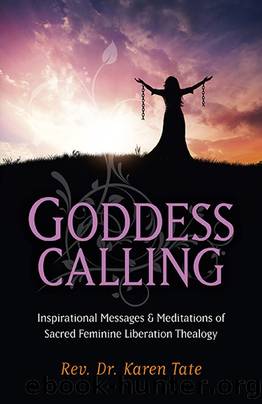Goddess Calling by Karen Tate

Author:Karen Tate [Tate, Rev. Dr. Karen]
Language: eng
Format: epub
ISBN: 978-1-78279-441-7
Publisher: John Hunt Publishing
Published: 2014-03-28T00:00:00+00:00
Chapter 12
Quest for Love and Wholeness
Many often consider the question, is the Divine male or female or both? Or is deity beyond gender altogether? The many answers to these questions have been cause for much argument, conversation, friction and oppression across the globe as women, trans-genders and gays are diminished within patriarchal Abrahamic religions.
Looking back into the past of many cultures, we see the Divine Source embodied both the Masculine and Feminine. Ometeotl, an androgynous Aztec creator-deity, embodied the principles of the Divine Masculine, called Ometecuhtli, alongside the Sacred Feminine, or Omecihuatl. We often see images of the Hindu Goddess Parvati and the God Shiva embodied within one statue, with Shiva himself often depicted having very androgynous features. We have discovered statues of Aphrodite and Ishtar with male genitalia. The Greek Goddess, Metis started out as a female, then becomes bi-sexual â a hermaphrodite â as in her aspect as Metis-Phanes, a creator and begetter all in one body. If these deities are any example, it is clear gender exists in many forms, as do human beings.
Examining deities perhaps a bit more familiar to us in the West, we take a closer look at Aphrodite and Eros/ Cupid. Eros is sometimes thought of as the son of Aphrodite, but he is really an enigma. He is first mentioned as an early creation-god appearing alongside Gaia and Chaos. He is said to be hatched from the Egg of Night, the force that separated the two halves of the Cosmic Egg, or Heaven and Earth. Similar to Aphroditeâs appearance at the birth of creation, she and Eros are placed at the moment of disunion of the cosmos. They are depicted as hermaphrodite beings, descended from the moon, sliced in half by Zeus, after which each half yearns and searches for the âother halfâ to be complete, their wholeness denied.
I was reminded of the dichotomy of love and disunion again as I walked through the Louvre Museum in Paris and gazed upon the famous statue of Hermaphroditus. Imagine for a moment youâre in the City of Lights, certainly imbued with the essence of the Feminine. Youâre standing in the vast courtyard of the Louvre, about to descend beneath the glass pyramid that marks the entrance to this world renowned museum some would call a sacred site. As you walk through the galleries of statues, one in particular catches your eye. At first glance, one might easily miss the full potency of what the statue represents and the deeper meaning it might tend to convey. When you approach Hermaphroditus from her backside, she appears to be a beautiful woman lounging naked on a divan. Walking around the piece, looking from the front view, you see the woman also has male genitalia. Hermaphroditus never fails to elicit staring and whispers from museum-goers, with most never really learning the story behind this work of art or thinking beyond their immediate titillation.
Hermaphroditus was the son of Mercury and Venus. When the boy was 15, he and the nymph Salmacis were so in love with one another that they prayed they would never part.
Download
This site does not store any files on its server. We only index and link to content provided by other sites. Please contact the content providers to delete copyright contents if any and email us, we'll remove relevant links or contents immediately.
Llewellyn's 2024 Witches' Companion by Llewellyn Publishing(240)
The Path of the Hedge Witch by Joanna van der Hoeven(225)
The Twelve Even Stranger Days of Christmas by Syd Moore(220)
Sexual Practices of the Druids by Jon G. Hughes(219)
Magic in the Landscape by Nigel Pennick(199)
Wicca Book of Spells Witches' Planner 2021: A Wheel of the Year Grimoire with Moon Phases, Astrology, Magical Crafts, and Magic Spells for Wiccans and Witches (Wicca for Beginners Series) by unknow(187)
The Turning of the Year: Lore and Legends of the Irish Seasons by Eithne Massey(181)
The Celtic Wicca Spell Book: The Magick and Mythology of Celtic Witchcraft by Didi Clarke(181)
Pagan Portals--Animal Magic by Rachel Patterson(172)
The Rising by Katherine Genet(170)
How to Thrive in Changing Times by Sandra Ingerman(169)
Green Witch: A Post-Apocalyptic Adventure (Dragon Wars Book 4) by Shéa R. MacLeod(168)
Animal Spirit Guides by Steven D. Farmer Ph.D(165)
World Shaman: Encountering Ancient Himalayan Spirits in Our Time by Ellen Winner & Mohan Rai(158)
Wiccan Celebrations by Silver Elder(157)
The Deep Heart of Witchcraft by David Salisbury(151)
Llewellyn's 2013 Witches' Companion by Lupa(145)
The Journey to the Sacred Garden by Hank Wesselman Ph.D(141)
Paganism 101 by Trevor Greenfield(136)
